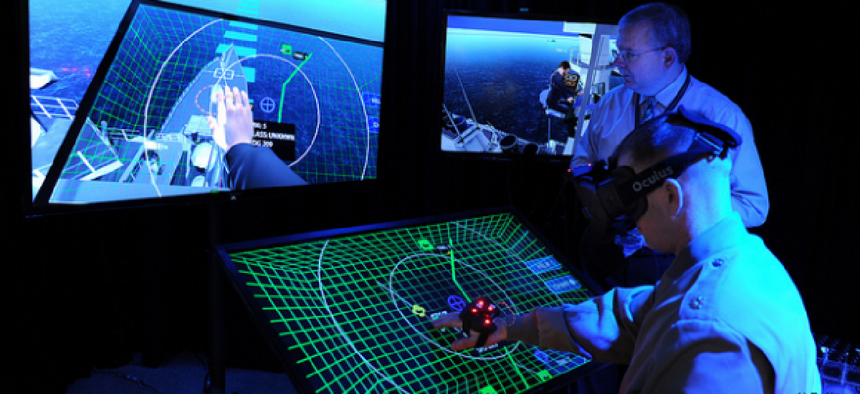Virtual reality headset helps Navy simulate future workspaces

The Office of Naval Research, working with USC's Institute for Creative Technologies, has developed a way to give Naval leaders a virtual view of their operational future.
The Office of Naval Research’s Project BlueShark is an effort to create a high-tech, futuristic environment to demonstrate what the Navy’s workspaces might look like and what emerging innovative technologies might provide in the next decade.
BlueShark was developed by the University of Southern California’s Institute for Creative Technologies (ICT) with funding from ONR and includes “virtual and augmented reality, virtual humans, artificial intelligence and human-computer interfaces,” said ICT. The project’s virtual reality technology would give ship operators a 3-D view of their environments, particularly useful in combat situations that could include moving ships, submarines, aircraft, missiles, torpedoes and depth charges.
One of the technologies being tested as part of BlueShark is Oculus Rift, a virtual reality headset originally designed for 3-D gaming. Among other things, Oculus Rift has been used to pilot drones, as well as simulate bomb disarmament.
Using virtual reality, the Navy can experiment with interfaces that might not yet be practical to build because technologies like holographic displays and augmented reality windows don't yet exist at scale, Mark Bolas, one of the USC project directors told the Verge. "But we can mock them all up in the head-mounted display," Bolas said.
The Oculus Rift virtual environment can quickly be modified to illustrate and test the latest interface concepts, like command and control and telepresence, Lt. Cmdr. Brent Olde, ONR’s warfighter performance division deputy, told Navy Times.
Oculus Rift, a noted standout at this year’s CES, is one of several VR headsets commercially available. Others include Carl Zeiss Cinemizer, Silicon Micro Display ST1080, Avegant’s Glyph and the Epson Moverio BT-200. In BlueShark, the headset is combined with a touchscreen board that simulates whatever controls the operator is working with.
The Navy is not the only military branch to explore virtual reality as a way to reduce training and simulation costs and improve readiness. The Army is using Quantum 3D’s ExpeditionDI technology to reinforce physical skills, such as how to position and fire weapons, and how to work together as a team in combat situations.
In a report last year, Deloitte Consulting not only mentioned that the military is at the forefront of developing the technology, but recommended that all agencies and departments start planning for implementations of it.





